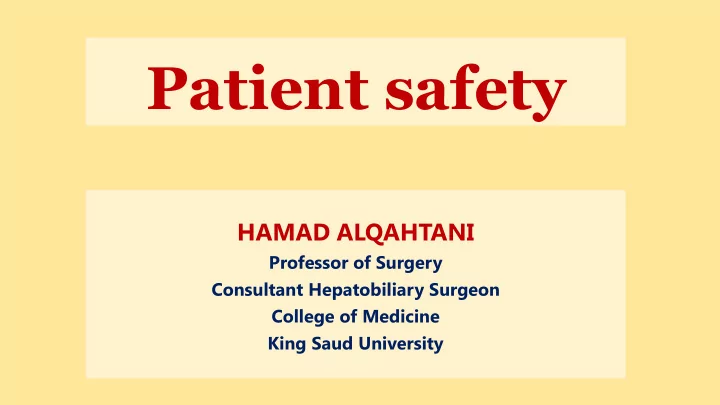

Patient safety HAMAD ALQAHTANI Professor of Surgery Consultant Hepatobiliary Surgeon College of Medicine King Saud University
Pati tient safety in incidents 1. These are preventable events that may cause unnecessary harm to the patient. 2. Patient safety has become a will established healthcare discipline with structured approaches which guarantee that all affected patients are cared for and informed.
Cla lassification of pati tient safety in incidents Adverse event. This is an incident that leads to patient harm. Near miss. This is an incident which could have caused unaccepted consequences but did not occur, either by chance or by preventing the occurrence of the event in appropriate time. No-harm event. This is an incident which occurs but did not harm the patient.
Common causes of f adverse events in in healthcare The most common factors that result in patient safety incidents are inadequate communication between: 1. The members of medical staff 2. The medical staff and the patients or the members of the patient family.
Causes of patient safety in incidents A. Human factors • Inadequate patient evaluation. • Delay or error in the diagnosis. • Inappropriate use or interpretation of investigations. • Error in doing an investigations, procedure, or treatment. • Inappropriate follow up or monitoring of the treatment. • Lack of experience. • Work over load and pressure of time. • Psychological or personal reasons (e.g. depression or drug abuse). • Variation in patient and environment of the work place.
B. System failures • Inadequate communication between the medical staff. • Inadequate levels of medical staff. • Shut down of the reporting systems. • Inadequate coordination between the staff at the handovers. • Similarities between the drugs. • Environment infrastructure and design. • Failure of the equipment, due to the lack of parts or skilled expertise. • Policies of cost-cutting taken by the health institute. • Inappropriate reporting systems of the incidents in patient safety.
C. Medical complexity • A new advanced technologies (e.g. robotic surgery). • Side effects and interactions of medications. • Place of work (emergency room, operating theatres, intensive care unit)
Patient safety in in th the real working conditions A. Communicating openly with patients and obtaining consent. B. The required information when obtaining the consent. • Details and accuracy of the diagnosis. • The goals and details of the planed procedure. • The possible complications of the planed procedure. • The possible prognosis. • Other treatment options, including the not to treat option. • Explanation of the advantages and possibility of success for each option. • The name of the responsible surgeon. • At any time, the patient can change his or her mind.
C. Professional behaviour D. Communication between the medical staff F. Reporting adverse events and near misses F. Prescribing safely • Inadequate clinical evaluation. • Inadequate information about the drugs. • Errors in the calculation of the dose. • Unclear hand writing. • Confusion in the name of the patient or mixing up of drugs.
Patient safety and the surgeon More than one cause of adverse events can be applied to many aspects of patient care during the perioperative period. The adverse events in the surgical practice that can potentially be committed by the treating surgeons in the patients care includes: • Prophylaxis errors. • Prescription errors. • Parenteral administration errors. • Awareness of situation, and teamwork errors. • Diagnostic and management errors. • Resuscitation errors. • Procedure technique and operative errors.
Sit ituation awareness – id identifying teamwork errors • The wrong patient was taken to the operating room. • Wrong site or side of surgery. • Wrong procedure or surgery. • Communication failure about changes in the condition of the patient. • Retained swabs or instruments.
Checklists Sign in Before induction of anaesthesia: This include 1. Confirmation of patient identity 2. Site and nature of procedure 3. Obtaining consent 4. Marking the site of procedure
5. Complete anaesthesia safety check • Functioning pulse oximeter on patient • Check for known allergy • Risk for difficult airway or aspiration with available equipment and assistance • Risk of blood loss more than 500ml with adequate intravenous access and fluids are available.
Time out (before skin incision) 1. All team members must introduce themselves by name and role. 2. Nurse verbally confirm ➢ The identity of the patient ➢ Site and nature of the procedure ➢ Anticipated critical events surgeon should mention what are the critical steps, duration of the procedure, expected blood loss Anesthesia team should mention any patient-specific concerns Nursing team should review the sterility been confirmed, equipment is available, any issues or any concerns, antibiotic prophylaxis has been given within the last 60 minutes, essential imaging is displayed.
Sign out (before the patient leaves the operating room) 1. Nurse should confirm verbally with the team: • The name of the procedure recorded • The instrument, sponge and needle counts are correct • Any equipment problems to be addressed. 1. The surgeon, anesthesia, and nurse review: • The concerns for recovery and management of the patient • The specimen is labeled including the patient name.
Technical and operative errors • During the conduct of the operation • Judgement errors (e.g. failure or late decision making to convert difficult laparoscopic into an open surgery). • Technical errors (steps of surgical procedure are not followed or omitted) • Aggressive handling of tissues that result in tissues damage. • Misinterpretation (this is unique to minimally invasive surgery due to the misreading of a two-dimensional image) • Misuse of surgical instruments (e.g. diathermy) • Missed iatrogenic injury (e.g. bile duct injury or bowel perforation)
Ethical aspect of surgery Informed consent • The surgical problem and the reasons why it needs surgery. • The proposed surgical procedure and how it might treat the surgical problem. • The expected complications of the proposed surgery. • The anticipated prognosis. • The alternative and potentially successful treatments. • The consequences of no treatment at all. Confidentiality
THANK YOU
Recommend
More recommend